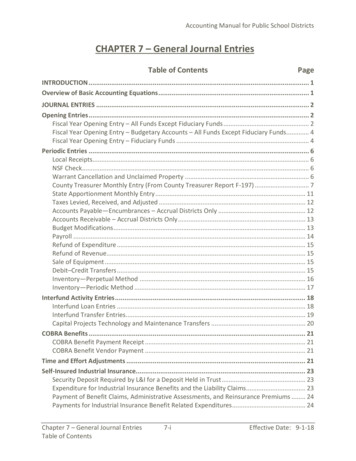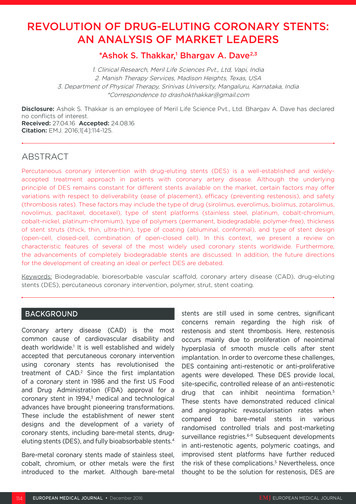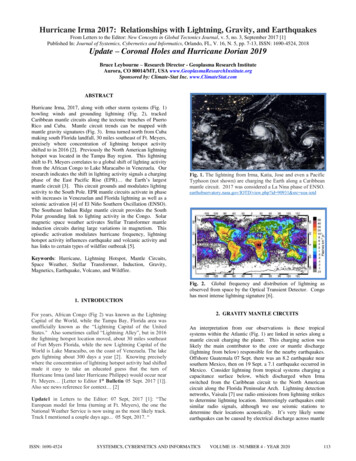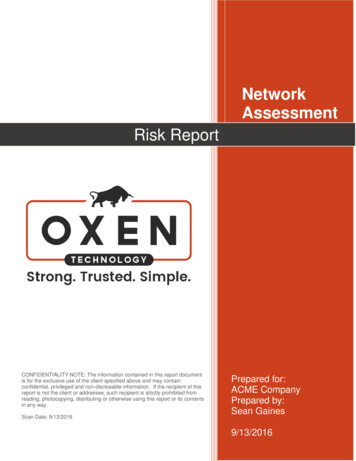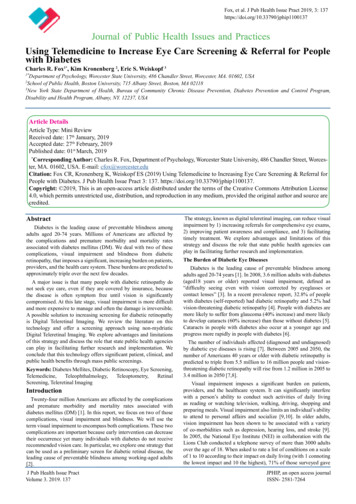
Transcription
Fox, et al. J Pub Health Issue Pract 2019, 3: 137https://doi.org/10.33790/jphip1100137Journal of Public Health Issues and PracticesUsing Telemedicine to Increase Eye Care Screening & Referral for Peoplewith DiabetesCharles R. Fox1*, Kim Kronenberg 2, Eric S. Weiskopf 31*Department of Psychology, Worcester State University, 486 Chandler Street, Worcester, MA. 01602, USASchool of Public Health, Boston University, 715 Albany Street, Boston, MA 021183New York State Department of Health, Bureau of Community Chronic Disease Prevention, Diabetes Prevention and Control Program,Disability and Health Program, Albany, NY. 12237, USA2Article DetailsArticle Type: Mini ReviewReceived date: 17th January, 2019Accepted date: 27th February, 2019Published date: 01st March, 2019*Corresponding Author: Charles R. Fox, Department of Psychology, Worcester State University, 486 Chandler Street, Worcester, MA. 01602, USA. E-mail: cfox@worcester.eduCitation: Fox CR, Kronenberg K, Weiskopf ES (2019) Using Telemedicine to Increasing Eye Care Screening & Referral forPeople with Diabetes. J Pub Health Issue Pract 3: 137. https://doi.org/10.33790/jphip1100137.Copyright: 2019, This is an open-access article distributed under the terms of the Creative Commons Attribution License4.0, which permits unrestricted use, distribution, and reproduction in any medium, provided the original author and source arecredited.AbstractDiabetes is the leading cause of preventable blindness amongadults aged 20-74 years. Millions of Americans are affected bythe complications and premature morbidity and mortality ratesassociated with diabetes mellitus (DM). We deal with two of thesecomplications, visual impairment and blindness from diabeticretinopathy, that imposes a significant, increasing burden on patients,providers, and the health care system. These burdens are predicted toapproximately triple over the next few decades.A major issue is that many people with diabetic retinopathy donot seek eye care, even if they are covered by insurance, becausethe disease is often symptom free until vision is significantlycompromised. At this late stage, visual impairment is more difficultand more expensive to manage and often the damage is irreversible.A possible solution to increasing screening for diabetic retinopathyis Digital Teleretinal Imaging. We review the literature on thistechnology and offer a screening approach using non-mydriaticDigital Teleretinal Imaging. We explore advantages and limitationsof this strategy and discuss the role that state public health agenciescan play in facilitating further research and implementation. Weconclude that this technology offers significant patient, clinical, andpublic health benefits through mass public screenings.Keywords: Diabetes Mellites, Diabetic Retinoscopy, Eye etry,RetinalScreening, Teleretinal ImagingIntroductionTwenty-four million Americans are affected by the complicationsand premature morbidity and mortality rates associated withdiabetes mellitus (DM) [1]. In this report, we focus on two of thosecomplications, visual impairment and blindness. We will use theterm visual impairment to encompass both complications. These twocomplications are important because early intervention can decreasetheir occurrence yet many individuals with diabetes do not receiverecommended vision care. In particular, we explore one strategy thatcan be used as a preliminary screen for diabetic retinal disease, theleading cause of preventable blindness among working-aged adults[2].J Pub Health Issue PractVolume 3. 2019. 137The strategy, known as digital teleretinal imaging, can reduce visualimpairment by 1) increasing referrals for comprehensive eye exams,2) improving patient awareness and compliance, and 3) facilitatingtimely treatment. We explore advantages and limitations of thisstrategy and discuss the role that state public health agencies canplay in facilitating further research and implementation.The Burden of Diabetic Eye DiseasesDiabetes is the leading cause of preventable blindness amongadults aged 20-74 years [1]. In 2008, 3.6 million adults with diabetes(aged18 years or older) reported visual impairment, defined as“difficulty seeing even with vision corrected by eyeglasses orcontact lenses” [3]. In a recent prevalence report, 32.8% of peoplewith diabetes (self-reported) had diabetic retinopathy and 5.2% hadvision-threatening diabetic retinopathy [4]. People with diabetes aremore likely to suffer from glaucoma (40% increase) and more likelyto develop cataracts (60% increase) than those without diabetes [5].Cataracts in people with diabetes also occur at a younger age andprogress more rapidly in people with diabetes [6].The number of individuals affected (diagnosed and undiagnosed)by diabetic eye diseases is rising [7]. Between 2005 and 2050, thenumber of Americans 40 years or older with diabetic retinopathy ispredicted to triple from 5.5 million to 16 million people and visionthreatening diabetic retinopathy will rise from 1.2 million in 2005 to3.4 million in 2050 [7,8].Visual impairment imposes a significant burden on patients,providers, and the healthcare system. It can significantly interferewith a person’s ability to conduct such activities of daily livingas reading or watching television, walking, driving, shopping andpreparing meals. Visual impairment also limits an individual’s abilityto attend to personal affairs and socialize [9,10]. In older adults,vision impairment has been shown to be associated with a varietyof co-morbidities such as depression, hearing loss, and stroke [9].In 2005, the National Eye Institute (NEI) in collaboration with theLions Club conducted a telephone survey of more than 3000 adultsover the age of 18. When asked to rate a list of conditions on a scaleof 1 to 10 according to their impact on daily living (with 1 connotingthe lowest impact and 10 the highest), 71% of those surveyed gaveJPHIP, an open access journalISSN- 2581-7264
Page 2 of 5eyesight a 10 [11]. In addition to its negative impact on quality of life,vision loss costs an estimated 51 billion each year in the U.S. [12].Diabetic retinopathy alone, independent of related impairments suchas cataracts and glaucoma, costs the nation more than 1 billion annuallyin direct medical expenditures for people 40 years and older [13].Prevention and DetectionAlthough retinal disease is common in people with diabetes, manypeople with retinal disease do not seek eye care because diabeticretinopathy is often symptom free until vision is significantlycompromised. At this late stage, visual impairment is more difficultand more expensive to manage and often the damage is irreversible.The most important approach to preventing sight-threatening diabeticretinopathy (DR) is early detection.When pathology is identified early, control of hyperglycemia, lipidlevels, and blood pressure can delay the progress of DR. In addition,success of treatment for DR with laser photocoagulation can beoptimized when implemented early, before symptoms are manifest[14,15].The benefits of early detection of diabetic retinopathy and otherdiabetic eye changes (including iris neovascularization, diabeticmacular edema, cataract and glaucoma) provide strong incentivesfor professionals and public organizations to advocate for regular,comprehensive eye exams. A comprehensive exam is conductedby an eye care specialist (an ophthalmologist or optometrist) whoassesses the entire health and function of the eye both before andafter the pupil is dilated. Pupil dilation allows the provider enhancedviewing of the structures of the eye, and greatly increases detectionand evaluation of diabetic retinopathy. Pupil dilation is a componentof a comprehensive eye exam, but is not a necessary procedure for ascreening. The American Diabetes Association (ADA) recommendsthat adults and children aged 10 years or older with type 1 diabeteshave a comprehensive eye examination with dilation within 5 yearsafter the onset of diabetes [16]. For people with type 2 diabetes, theADA recommends a dilated and comprehensive eye examinationshortly after the diagnosis of diabetes, and annually thereafter.Finally, women with diabetes who are planning pregnancy or whohave already become pregnant, should have a comprehensive eyeexamination, according to the ADA, and should be counseled onthe risk of development and/or progression of diabetic retinopathy.The ADA recommends an eye examination in the first trimesterwith close follow-up throughout pregnancy and for 1 yearpostpartum. Comprehensive eye exams for people with diabetesis also recommended by other professional organizations (i.e.American Academy of Family Physicians, American Academy ofOphthalmology, American Association of Clinical Endocrinologists,American College of Physicians, American Optometric Association,Centers for Disease Control and Prevention, the National EyeInstitute, and others).Barriers and ChallengesDespite the availability of evidence-based prevention and treatmentprotocols for DR many adults with diabetes are not screened for thepresence of diabetic retinopathy [12,17]. The National Committeefor Quality Assurance, Health Plan Employer Data and InformationSet (HEDIS ) 1 of 2009, reported that for adults between the ages of18 and 75 who were diagnosed with diabetes, only 56.5% of thosecovered by commercial health plans, 63.5% covered by Medicare,and 52.7% covered by Medicaid had a retinal exam in the prior year[18]. Similarly, Healthy People 2010, set an objective of annualdilated eye exams for 75% of adults with diabetes; to date (2008)only 53% of people of this age group with diabetes ( 18) had actuallyreceived dilated eye exams [6].Definition of Vision ScreeningScreening as a means of detecting diabetic eye diseases early iswell supported in the literature. However, the definition of the termJ Pub Health Issue PractVolume 3. 2019. 1371“vision screening” is inconsistent thus confounding the implicationof research results. Some researchers and authors use the term“vision screening” to specifically reference varied and sometimeconflicting state mandated regulations. Some studies refer to amedical procedure that identifies those at risk for eye disease whileothers use the term to refer to a diagnostic procedure, and still othersuse the terms “vision screening” and “diagnosis” interchangeably. Inthis paper, we use “screening” to denote a preliminary assessmentof risk. A vision screening, therefore, is like a mammography orcolonoscopy in that it assesses an individual’s likelihood of havingdisease. Just as a mammography or colonoscopy may be followedby referral for a biopsy to confirm a diagnosis, a vision screeningmay result in referral fora diagnostic procedure, the comprehensive,dilated eye exam.Method of Digital Teleretinal ImagingIn 2004, the American Telemedicine Association (ATA) publishedthe “Telehealth Practice Recommendations for Diabetic Retinopathy,”representing a comprehensive review of existing evidence on oculartelehealth for diabetic retinopathy [19]. It summarized clinical, ethicaland technological recommendations for effective implementationof a teleretinal imaging program. Other research demonstrates theeffectiveness of teleretinal imaging as an effective means to screenpeople with diabetes for diabetic retinopathy [20,21] and as a meansof improving adherence to screening guidelines and eye care [22,23].With teleretinal imaging, technicians at primary care offices orother local or mobile imaging centers capture stereo images ofthe retina using a digital camera. The images can be electronicallytransmitted to and interpreted by trained interpreters, optometrists,or ophthalmologists, who may be offsite. The readers evaluate theimage for evidence of diabetic retinopathy (or other pathology) andmake a referral recommendation to the primary healthcare providersbased on established protocol.Teleretinal imaging can be performed with mydriatic or nonmydriatic cameras (those requiring pupil dilation versus thosethat don’t). In a 2001 randomized clinical trial, non- mydriaticcameras were shown to be comparable in their accuracy in detectingretinopathy to the established gold standard established in the EarlyTreatment Diabetic Retinopathy Study (ETDRS), which requiredpupillary dilation [24]. Other studies have corroborated thoseresults [20], with one study concluding that non-mydriatic digitalimaging improves the rate of identification of diabetic retinopathy[25]. While researchers do not all agree on the greater efficacy ofthe non-mydriatic camera, the non-mydriatic camera has importantadvantages. Dilating the patients’ eye requires administration ofcontrolled substance drops and thus requires a licensed provider.Dilation is disruptive to vision and visual function typically formany hours, and it is time consuming. These disadvantages increasebarriers to screening and early detection.A Potential Approach to Reduce Barriers to Screening and EarlyDetection. The following are some of the attributes of the nonmydriatic teleretinal imaging technology.Patient AwarenessLack of patient awareness of the importance of an eye care visithas been cited as an obstacle to eye health [26,27]. Interventions toincrease patient awareness alone have proven effective at increasingscreening rates [28]. This was demonstrated in two Veterans Affairsclinical studies utilizing the Joslin Vision Network Eye HealthCare Model telemedicine program for diabetic retinopathy. In oneproject in Boston [25], and another in Maine [29], the digital imageresulting from the process, using non-mydriatic technology, wasfound to increase the ability of the imaging specialist to educate thepatient about the disease. The American Telemedicine Associationrecommends that provider-patient communication be a component ofa telehealth program [19].HEDIS is a registered trademark of the National Committee for Quality Assurance (NCQA).JPHIP, an open access journalISSN- 2581-7264
Page 3 of 5Primary Care Provider KnowledgeLimited eye health knowledge by primary care doctors has alsobeen raised as an impediment to adherence to eye care guidelines. Ina national web-based study of primary care physicians conducted in2007, only half of physicians believed they had adequate knowledgeto advise their patients on vision health, and only 58% believed theycould identify patients at higher risk for eye disease [27]. With anon-site teleretinal imaging system, identifying patients is done bythe trained imager, the off-site reader, and the technology, therebyaddressing this knowledge gap.Physician Communication/RecommendationSeveral studies have validated patient reliance on the adviceof their primary care physician. It follows that when there is nopersonal physician recommendation for an eye exam, patients donot know that such an exam is important. Unfortunately, referral forcomprehensive eye exams by primary care providers are far fromuniversal or automatic [30]. In a qualitative study conducted by theNational Eye Institute in 2005, a majority of participants over theage of 40 said they do not visit an eye doctor because such a visitwas not recommended by their doctor [31,27]. A majority of studyrespondents also said that their primary care doctor does not lookinto their eyes or talk to them about their vision health during theirphysical exam. Locating the camera equipment in the primary careoffice has been shown to circumvent that barrier and increase referralsto eye care providers [32]. A clinical trial conducted at three primarycare clinics of the Indian Health Service in Arizona over five years,resulted in a 50% increase of annual retinal examinations followedby a 51% increase in laser surgery treatment rate [33].Transportation BarriersScreening with teleretinal imaging equipment can also help reducetransportation barriers. In a primary care office, patients can gettheir screening in a familiar setting, on the same day they visit theirdoctor, limiting the need for multiple trips, reducing time off fromwork and its related income loss, and limiting transportation costs.Teleretinal imaging is now being conducted in mobile eye clinicsthat can travel to communities to provide service, thereby addressingpatient transportation challenges. The success of these efforts willneed to be evaluated.Eye Care Provider AvailabilityStudies in rural areas [34,20,35] indicate the advantage of the useof digital retinal imaging in primary care and community settings toincrease screening of diabetic eye diseases in areas where availabilityof eye care providers is low and transportation to eye care is difficult.The advantage of non-mydriatic imaging – it does not require pupildilation -- enables the establishment of the equipment in settingsother than the eye care professional office, and opens the door foruse by those who are not eye care doctors. Technicians can be rapidlytrained to use the non-mydriatic imaging equipment [20]. In addition,non-mydriatic cameras have been well received by patients [20,35].The digital imaging system helps providers screen for evidence ofdiabetic eye disease and refer to the eye care provider only thosepeople identified as at risk of diabetic eye complications. This systemof triage has the potential of reducing long waits for appointmentsand follow-up with eye care providers. The potential for teleretinalimaging to increase referral for comprehensive eye exams in areasof low eye care provider availability and transportation challenges ispromising and would benefit from further research.Cost/Economic BarriersResearchers have begun to investigate the economic feasibilityand cost-benefit ratio of teleretinal imaging. In a 2009 review articleon the economic evidence for diabetic retinopathy screening, theauthors conclude, “Digital photography with telemedicine links hasthe potential to deliver cost effective, accessible screening to rural,remote and hard-to-reach populations” [36].J Pub Health Issue PractVolume 3. 2019. 137Additional research suggests this method has potential for costsavings. An analysis of the Joslin Vision Network (JVN) teleretinalimaging system versus conventional clinic-based ophthalmoscopyconcluded that the JVN “has the potential to be more effective thanclinic-based ophthalmoscopy for detecting proliferative diabeticretinopathy and averting cases of severe vision loss, and may do soat lower cost” [37].At the University of California, Berkeley, a license-free, web-based“store and forward” system (images are stored and sent to trainedreaders) was designed to reduce barriers to access to retinal examsfor diabetes patients. It has been used in over 120 primary caresites throughout California and else where. Two articles describingthe system and the research suggest potential economic savingsand improved access to eye health care from the use of this system[38,37]. In one article, the authors project that “for each patientexamined for retinopathy with store and forward telemedicine, thecost savings to the state will total nearly 2,500 over the patient'slifetime [38].” Further research on financial benefit of implementinga teleretinal imaging systems in a primary care setting is necessary.Public Health RolesState and local public health agencies can play important rolesin the prevention of diabetes-related vision loss by supporting andimplementing interventions that increase the rate of comprehensive,dilated retinal exams via a variety of strategies and by promotingevolving technologies such as teleretinal imaging. The followingtasks foster those goals:Assess Numbers of People at Risk and Barriers to Screening andEarly Detection Assess the impact of diabetes and identify populations at greatestrisk for diabetes-related eye diseases, where these people arelocated, and their barriers to getting regular, comprehensiveeye exams. Use data sources such as the Behavior Risk FactorSurveillance System (BRFSS) vision module, and statelevel M
of a teleretinal imaging program. Other research demonstrates the effectiveness of teleretinal imaging as an effective means to screen people with diabetes for diabetic retinopathy [20,21] and as a means of improving adherence to screening guidelines and eye care [22,23]. With teleretinal


